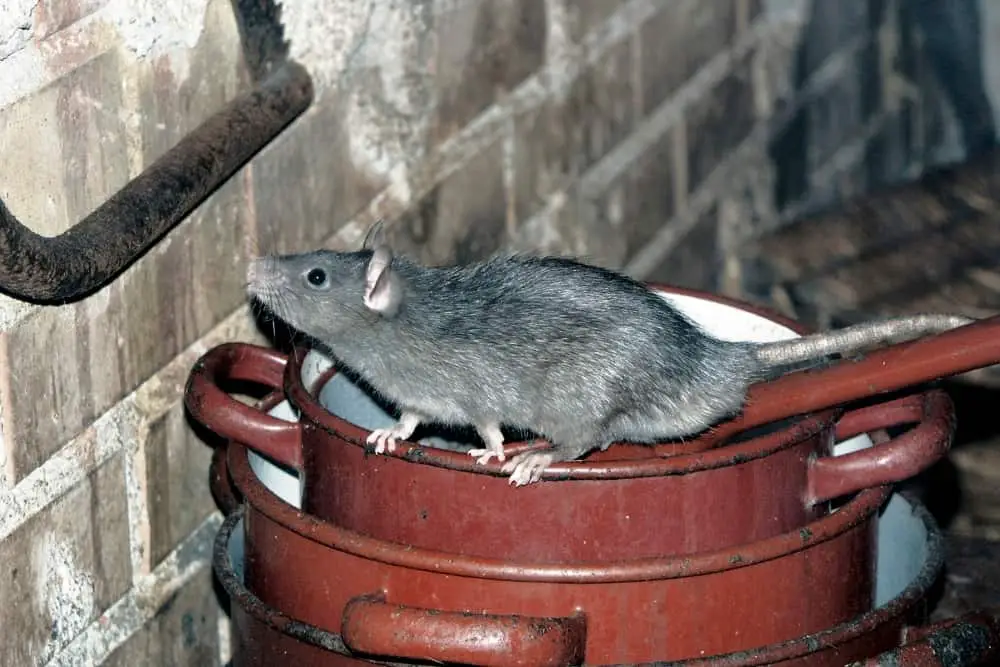While at first glance this may seem like a silly question, it makes a lot of sense.
Rats are renowned for their ability to hide away in even the smallest of spaces, particularly tiny holes, making it appear that they’re completely boneless.
Some people even see this and wonder if the bones of rats somewhat collapse when they need to squeeze through tiny nooks and crannies.

But rats do have bones. They have entire skeletons just like all vertebrates.
Despite the myth, these bones aren’t collapsable at all and don’t bend in any way, as this would lead to breakage, just as it would in humans.
The main reason why they’re able to maneuver so impressively is because of their natural flexibility and narrow, cylindrical shape.
What Bones Do Rats Have?
Rats have a regular internal skeletal structure, similar to all rodents. Believe it or not, rats actually have more bones than we humans do! In total, rats have 223 bones in their small bodies.
This is 17 more bones than found in the human body. Just like many other mammals, the bones of rats serve the purpose of protecting their internal organs as well as supporting and balancing the body.
If rats didn’t have bones, they wouldn’t really be rats anymore – their entire bodies would collapse and have no structure.
Rats even have bones in their tails. A layer of bones surrounds the rat’s tendons, which are ultimately wrapped in the flesh in the rat’s tail. It’s also a frequent misconception that rats’ tails have no sensation.
This is untrue; when their tail is handled or injured, they can absolutely feel it. In fact, their tails are extremely sensitive and aid in regulating their body temperature.
Another popular misconception is that rats lack a backbone. This is entirely incorrect; rats do, in fact, have a spine. Because they can squeeze through such small spaces, some believe they don’t have backbones.
They can squeeze through some of these small holes not because they lack a spine, but because their back has developed in such a manner that it permits them to fit through openings the width of their heads.
What Size Holes Can Rats Fit Through?
A rat can squeeze through a hole roughly the size of a quarter or about 1 inch in diameter. They have even been known to crawl through the gap at the bottom of doors.
Because they devote so much of their time underground in the wilderness, they are able to do this. They dig tunnels to protect themselves from threats, gain access to adequate food, and shelter.
It’s crucial for them to have a rather pliable skeleton to navigate these tunnels, therefore they’ve evolved to have one!
They also lack collarbones and have extremely strong legs, all of which aid them in navigating through confined spaces.
Pet rats, on the other hand, are able to become stuck in little holes. This is attributable to the reality that pet rats are more typically plump than undomesticated rats, not because of their bones.
As a result, they underestimate their own dimensions in relation to the opening they’re trying to squeeze through, causing them to become trapped.
Smaller rats can squeeze through an opening the size of a quarter, or 0.96 inches, and mice can fit through a hole the size of a quarter of an inch. This must be taken into account while rat-proofing your outbuildings.
When covering entry holes, a 12 inch by 12-inch mesh is advised, as wire mesh with 1 inch by 1-inch holes would not be effective against little rats.

Can Rats Get Stuck?
Yes. Rats getting trapped in small openings is entirely possible. It has, in reality, happened before. Rats’ bodies are lengthy and pliable, but that doesn’t mean they don’t get stuck in holes. Especially while heading toward their favorite foods!
When rats race away, they may make a mistake about the size of the hole. They will try to force themselves through it despite the fact that it is insufficiently large, becoming caught in the middle.
In other cases, obese rats overestimate their own dimensions, believing they are small enough to fit.
Rats are often only stuck for a brief period of time due to their elasticity and form. In a couple of moments, they drag themselves out from the hole to the next one.
If they fail, whether owing to a faulty calculation or another reason, human intervention may be required.
Can Rats Sneak Into My House?
Rats are inquisitive pests, which means they will infiltrate your home through any accessible entrance. This involves vents and wall gaps.
Rats, as you may know, can squeeze through even the smallest of openings. Most people are unaware that rats can retain their breath for up to 30 minutes, making pipelines and plumbing suitable access points as well.
If you catch yourself in the middle of a rat infestation, you can use rat poison or traps to get rid of it.
An exterminator may be required in more extreme situations. It is also essential that you properly inspect your home. This entails searching every nook and corner for even the tiniest of openings.
Nevertheless, a cursory examination may be insufficient. Cover or seal any probable entrances you come across.
Do not leave the doors in your home wide open, and keep a tight cover on your composting container and trash cans at all times. Consider putting a wire mesh, as previously recommended.
The very first phase of rodent prevention is to rat-proof your home. You’ll have less to worry about if they can’t get in.
Rats will take any opportunity they can to enter your home, as they are often in search of shelter and almost always on the hunt for their next meal.
